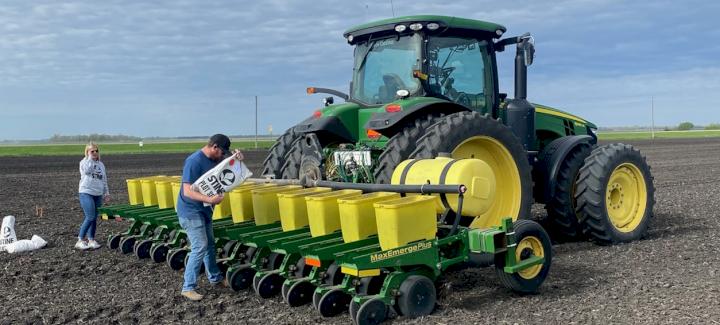
Late-planted corn and soybeans are a concern for many growers across the U.S., especially for those in the northern Corn Belt — from Michigan to the Dakotas — as cool temperatures and rainfall persist. Even regions as far south as Kentucky have been affected by pendular weather keeping them out of the fields. For corn growers who have been unable to get their crops in the ground, not all hope is lost to save yield. But fertility management will be key to homing in on the full genetic potential of the seed.
Fertility management
When you lose growing degree days, high-yield potential can be affected, but proper fertility management can help. Iowa State University Extension and Outreach says, “The placement of small amounts of plant nutrients in bands offset to the side and below the seed row or in the seed furrow increases the concentration of nutrients near seedling roots.”
If growers are not equipped to put a starter down, there are alternative ways to incorporate nutrients into your planned fertilizer program.
“Some growers may not have fertilized yet this year because of high input prices and weather concerns,” says Todd Schomburg, Stine’s director of agronomy. “That said, if you plant late, you need to consider using crop removal rates for your fertility program to protect the genetic potential of your seed. Remember to use realistic yield goals when applying nitrogen, phosphorus and potassium. And, as in any good fertility management program, don’t skip the sulfur.”
If you conducted soil sampling last fall or early this spring, you likely have a good idea of what inputs are needed. But if you were unable to complete soil sampling, be sure to follow your state’s fertility recommendations.
For example, according to Michigan State University Extension, crop nutrient removal for soybeans is .8 pounds per bushel of phosphorus and 1.4 pounds per bushel for potash. For corn, removal is .9 pounds per bushel of nitrogen, .37 pounds per bushel of phosphorus and .27 pounds per bushel of potash.
Always keep in mind that the bigger the yields at harvest, the bigger the nutrient loss for your next crop.
Crop switch
If you’re past being able to plant corn, it’s time to consider a different crop. For growers who choose to switch to soybeans, make sure you consider which herbicides were previously applied to the ground. For example, if an HPPD inhibitor (HPPDi) was previously applied to corn, there are HPPDi-tolerant soybean options available, including Stine® LibertyLink® GT27® soybeans.
“Because of their overall effectiveness, HPPDi herbicides are a staple in the U.S. corn market. It’s estimated that roughly half of U.S. corn acres have HPPDi-based chemistries applied to them. Fortunately, Stine LibertyLink GT27 soybeans have built-in tolerance to HPPDi/Group 27-based herbicides, which means they have extra protection against potential HPPDi/Group 27 carryover,” says Schomburg.
If switching to a shorter-season corn product, consider a hybrid that’s tolerant to disease pressure. Cool temps and wet soils are a catalyst for disease growth so know which diseases typically affect your region in years like this and plan as best you can.
Increased soybean populations
We recommend growers who are faced with late planting of soybeans increase populations slightly.
“When you increase populations on soybeans, the goal is to get more vegetative growth. This allows for an easier harvest and minimizes yield loss. And the taller and wider your plants get, they begin to shade the rows which helps limit weed competition,” says Tony Lenz, Stine corn technical agronomist.
Tony adds that soybean growers still have time before they need to consider an alternative maturity. “If you already have something that aligns with your planting plan and region, there’s no need to switch to an earlier maturity just yet.”
Seed treatments
If you’re still waiting to plant soybeans, seed treatments, including inoculants, are still a viable option. Seed treatments help protect the genetic potential of your seed, which can be critical in a year such as this. Where cool, wet soils persist, so do diseases that thrive in these conditions.
“We have a handful of seed treatment options available to help ward off the early onset of diseases and insects,” Schomburg says. “Stine XP soybean seed treatments come in four custom-blend formulations, including Stine XP Complete, Stine XP-F&I, Stine XP-F&I with BIOst® Nematicide and Stine XP-F. You can find information about each option on our website or by connecting with your local Stine sales rep or seed dealer.”
Prevented plant deadlines
One big thing to keep in mind as you consider what can be done with any acres left unplanted is the prevented plant deadlines for each state. Prevented planting provisions should be available in each insurance policy, but growers must recognize that any acres planted after the prevented plant date may be subject to less coverage. That said, it’s always a good idea to consult with your insurance company and local seed rep to discuss whether prevented plant coverage is a better option than late-planted hybrids or varieties.
For more recommendations on managing your late-planted corn or soybean acres, consult with your local Stine sales rep or regional sales agronomist.
Related Articles
-

Stine® to offer Syngenta’s Victrato® soybean seed treatment in 2026
December 2025 in Agronomy
-

Use Stine’s XP® seed treatments to prevent early injury to your crops
December 2025 in Agronomy
-

Understanding Stine’s enhanced oil profile soybeans
December 2025 in Agronomy
-

Soil sampling sets the stage for spring
November 2025 in Agronomy



